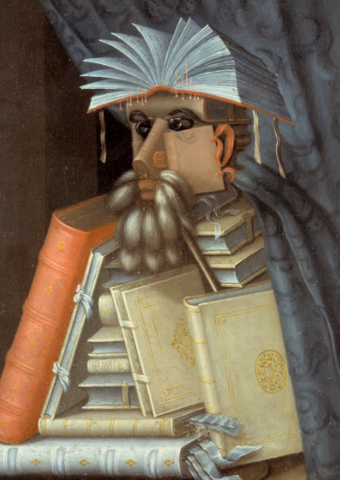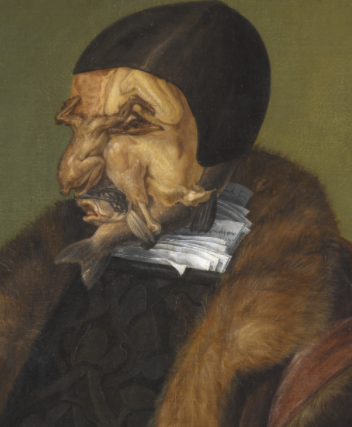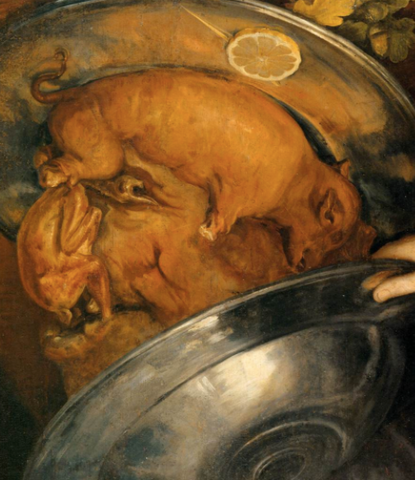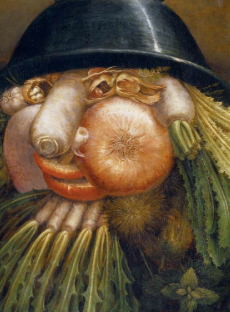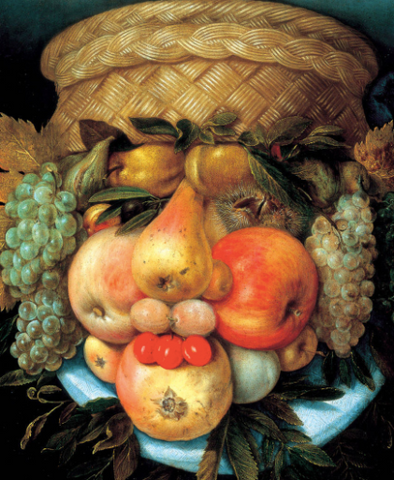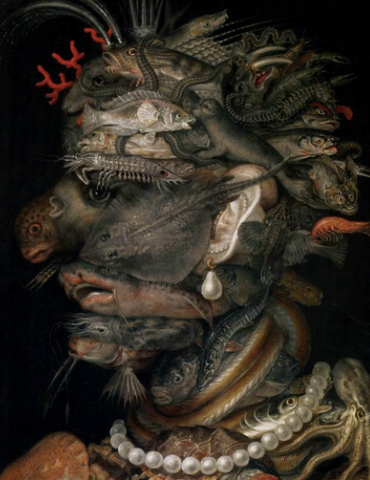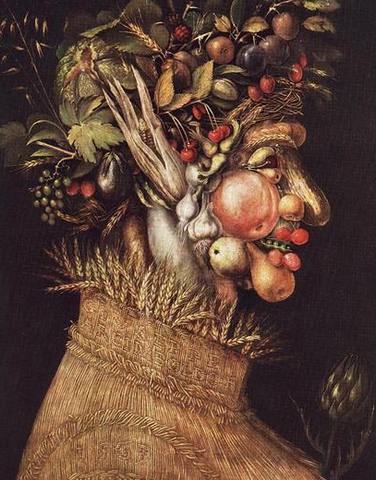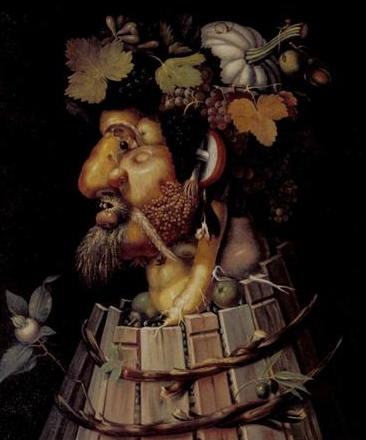Giuseppe Arcimboldo's Most Famous Paintings
Who is Giuseppe Arcimboldo?
Giuseppe Arcimboldo (sometimes spelled Arcimboldi) was born in Milan, in 1526, or 1527; a son of Biagio Arcimboldo - a designer of frescoes and stained glass. Giuseppe followed in his father's footsteps, as a 21-year-old man, working at local cathedrals. However, this was only the beginning of a fruitful career - in 1562 Giuseppe Arcimboldo became the court portraitist, at a court in Vienna, to Ferdinand I, the first of three Emperors of the Holy Roman Empire he served in this position throughout the course of his lifetime. He continued his career, at the court in Prague, under Ferdinand's successors - Maximilian II, and Rudolf II, serving also as a court decorator, and costume designer.
At the end of the Thirty Years War, in 1648, Prague was invaded by the Swedish Army, and many of Giuseppe Arcimboldo famous paintings were seized from the collection of Rudolf II.
A large body of his work had fallen into oblivion until 1885 when art critic Kasati published the monograph "Giuseppe Arcimboldi, Milan Artist". The works Arcimboldo is famous for are his unique characters. The portraits made of books, fruits, vegetables, and everyday objects - are the paintings that spring to mind, today, when Arcimboldo's name is mentioned. Furthermore, we have to thank the Surrealists of the early 20th century, especially Salvador Dalí, who truly rediscovered his work. In 1987, at the Palazzo Grassi, in Venice, the exhibition entitled "The Arcimboldo Effect: Transformations of the face from the 16th to the 20th Century” was held. Currently, Giuseppe Arcimboldo paintings are scattered across the world, in private collections, and state museums.
Giuseppe Arcimboldo's Famous Paintings
Below are 13 of Giuseppe Arcimboldo's most famous paintings:
- The Librarian by Giuseppe Arcimboldo
- Vertumnus by Giuseppe Arcimboldo
- The Jurist by Giuseppe Arcimboldo
- The Cook by Giuseppe Arcimboldo
- Four Seasons in One Head by Giuseppe Arcimboldo
- The Gardener by Giuseppe Arcimboldo
- Reversible Head with Basket of Fruit by Giuseppe Arcimboldo
- Fire by Giuseppe Arcimboldo
- Water by Giuseppe Arcimboldo
- Spring by Giuseppe Arcimboldo
- Summer By Arcimboldo Giuseppe
- Autumn by Giuseppe Arcimboldo
- Winter by Giuseppe Arcimboldo
Giuseppe Arcimboldo Artworks
The Librarian by Giuseppe Arcimboldo
One of the best known of Arcimboldo's works, and the one that spurred a lot of debates - "The Librarian" is in Skokloster Castle in Sweden. It was brought to Sweden, after the Battle of Prague, and was the property of General Hans Christoff von Königsmarck. The original name of the painting is unknown.
The person believed to be represented is Wolfgang Lazius - Austrian Humanist, and Historian, who served the House of Habsburg. The work is dated between 1562 and 1566. The body of "LIbrarian" consists of books and bookmarks. Some art scholars interpret the painting as the celebration of the trade, others see it as a satire, aimed at book collectors.
Francois Boucher Most Famous Paintings
Vertumnus by Giuseppe Arcimboldo
The Skokloster Castle is home to another one of Giuseppe Arcimboldo Most famous paintings - Vertumnus. This painting was produced in Milan, between 1591 and 1592, at the end of Arcimboldo's career, and - life. It is a portrait of Rudolf II, The Emperor of the Holy Roman Empire. Rudolf is depicted as Vertumnus, the Roman god of metamorphoses in nature, and life.
The image constitutes of pears, apples, cherries, gourds, grapes, olives, pumpkins, cabbage foils, wheat, figs, and various other fruits and vegetables of all seasons, to symbolize the golden age Rudolf's reign has brought.
John Everett Millais Most Famous Paintings
The Jurist by Giuseppe Arcimboldo
The National Museum of Fine Arts in Stockholm houses "The Jurist". The painting is also known as "The Lawyer". It was acquired from the collection at Gripsholm Castle in 1866.
There are two suggested subjects - prominent figures of the time - German jurist, Ulrich Zasius, and religious reformer, Jean Calvin. The face is depicted by poultry, and fish, while the body consists of legal documents. The work is thought to be a caricature of a member of a legal profession.
Giorgione Most Famous Paintings
The Cook by Giuseppe Arcimboldo
The National Museum of Fine Arts in Stockholm possess "The Cook". It was painted c.1570. This still life of roasted meats on silver plate; when reversed (as it's now) showcases a human face.
Top 10 Most Famous Paintings by Wassily Kandinsky
Four Seasons in One Head by Giuseppe Arcimboldo
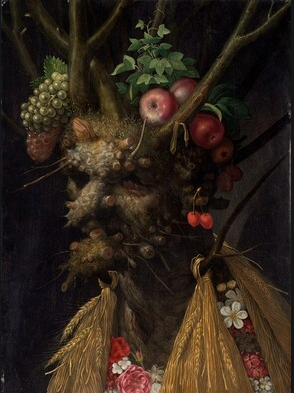
"Four Seasons in One Head" - the painting that can be considered a "crowning achievement" of Arcimboldo, is displayed in National Galery of Art, Washington, D.C., USA.
It was painted in Milan, c.1590 after Arcimboldo returned to his hometown. The fruits of all seasons are combined into a puzzling portrait, to accommodate the fashion of the late Renaissance.
Top 10 Most Famous Paintings by Thomas Sully
The Gardener by Giuseppe Arcimboldo
One of the best-known works of Arcimboldo - "The Gardener" (L'Ortolano), also known as "The Vegetable Gardener", or "Vegetables in Bowl" was painted in his homeland, Italy, at the Museo Civico Ala Ponzone, in Cremona. It was painted between 1587 and 1590. When reversed (as it's now) it shows a human face.
Some of the vegetables resemble genitalia of both sexes, which suggests that the person depicted could be Priapus - ancient Greek god of fertility, protector of gardens.
Eugene Delacroix Most Famous Paintings
Reversible Head with Basket of Fruit by Giuseppe Arcimboldo
"The Fruit Basket", or "Reversible Head with a Fruit Basket" was painted c.1590. Just like "The Gardener", and "The Cook", when reversed, it shows a human face as it is now. It's in the possession of French and Company in New York.
Top 10 Most Famous Paintings by Sandro Botticelli
Fire by Giuseppe Arcimboldo
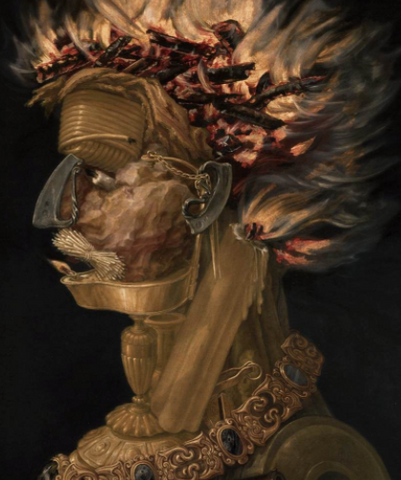
Arcimboldo produced two series of paintings, exploring themes popular throughout the Renaissance world - "The Four Elements", and "The Four Seasons"."The Four Elements" were painted in 1566. The series was commissioned by Maximilian II; today however the collection is split - "Air", and "Earth" are in private collections, while "Fire", and "Water" are in Kunsthistorisches Museum, in Vienna, Austria. This series attempted to present the birth of harmony out of chaos.
"The Fire" stands apart from the others. It is the only one formed out of inanimate objects. The figure consists of cannons, the symbols of the military power of the Empire. The hair of the figure - the flames are sprouting from burning wood.
Top 10 Most Famous Paintings by Georgia O'Keeffe
Water by Giuseppe Arcimboldo
"The Water" is presented somewhat as a female face; sculpted from marine creatures. The spines of fish and coral form the crown. A pearl necklaces surrounds the neck of the figure, helping the shape to emerge from the chaos.
Giuseppe Arcimboldo offered an accompanying set to "The Four Elements", to Maximilian II in 1569 - "The Four Seasons". Giovanni Battista Fonteo wrote a poem, corresponding to the series and explaining the allegory of the series. The series was painted between 1563 and 1573.
Top 10 Most Famous Paintings by John William Waterhouse
Spring by Giuseppe Arcimboldo
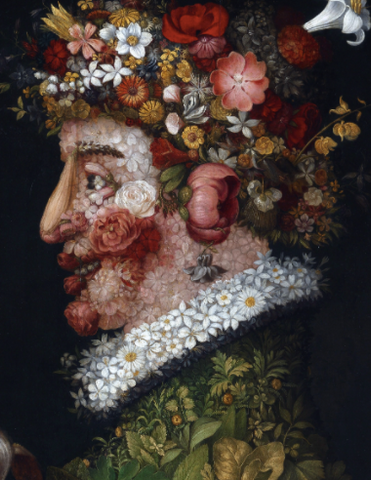
"The Spring" relates to "The Air". Its face is comprised of flowers in bloom and green leaves. Perhaps one of the most joyous faces Arcimboldo ever painted. The face of "The Air" is depicted with a plethora of birds. The peacock and the eagle represent the Habsburg dynasty. This piece survived only as a copy.
Top 10 Most Famous Paintings by Henri Matisse
Summer By Arcimboldo Giuseppe
The next in line in the series, one of the Giuseppe Arcimboldo most famous paintings, "The Summer" - is a face of happiness. It relates to "The Fire" from the "The Four Elements" set. Pees, garlic, plums, eggplant - all feature the face of summer; its body covered with a coat of wheat.
Top 10 Most Famous Paintings by Andy Warhol
Autumn by Giuseppe Arcimboldo
The most fruitful season of them all - "The Autumn" relates to "The Earth". His nose is pear, he has a mushroom for an ear, a pumpkin for a hat, and grapes form the hair. This piece has the most warmth in the whole set, even more than "The Summer". "The Earth" is represented by land animals thickly intertwined into a stout face, antlers joining together, to form a crown. The Golden Fleece on the bosom of the figure is a symbol of the Knightly Order, of which the Emperor was a member.
Dante Gabriel Rossetti Most Famous Paintings
Winter by Giuseppe Arcimboldo
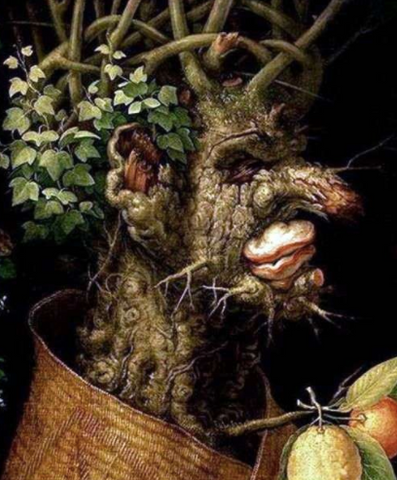
The last season - "The Winter", bares almost no fruits. The figure is composed of roots of the trees and features only some leaves of the evergreen trees. Its costume is a straw mat. "The Winter" relates to "The Water", from "The Four Elements" set.
Kunsthistorisches Museum in Vienna possesses the only two surviving original pieces - "The Summer" and "The Winter". Real Academia de San Fernando, in Madrid, is in the possession of "The Spring" from the set copied for Philip II, the King of Spain. The only full set is in the Louvre. It is a copy made by Arcimboldo, for the Emperor, to send to Augustus of Saxony. This set has a floral frame, that was not used in the original version, and features the dynastic symbols of Elector Augustus.
Giuseppe Arcimboldo work bursts with joy and humor. Luckily. His joyous art was saved for all the future generations, to enjoy, and cherish. Giuseppe Arcimboldo paintings are the fun side of art. These works have such a profound influence on the observer, the fact that they were almost, forgotten seems quite impossible.
Top 10 Famous Paintings By Suzanne Valadon
Giuseppe Arcimboldo Paintings Slideshow
Check out these Famous Artists who have shaped the art world!
If you like this article, please share it with others, so perhaps they can also enjoy it and get value from it. Any of the artwork purchased on ATX Fine Arts accommodates me as an artist/ writer along with helping the site grow organically, thank you.

